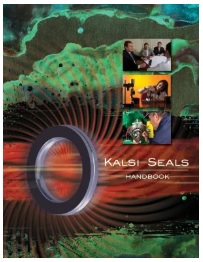
Our online seal handbook, which provides guidelines for implementing Kalsi-brand rotary shaft seals in rotating equipment, has been revised. Highlights of the revisions follow.
Chapter D7 “Extrusion gap considerations” — Chapter D7 underwent a major rewrite to address the extrusion gap implications of a significantly expanded rotary shaft seal product line. Our product line now includes seals with significantly increased pressure capacity, seals that operate with significant pressure acting in either direction, and high pressure lip seals. The chapter was also reorganized to improve clarity and eliminate redundancy.
Chapter D14 “Shaft guided compensation pistons” — The main reason for revising Chapter D14 was to add information about the use of redundant pressure compensation pistons. Additional information about using coil springs with pressure compensation pistons was provided. The cover image was revised for increased realism. Minor editorial changes were made to improve grammar and eliminate unnecessary internal cross-references.
Chapter D15 “Integral journal bearings” — The main reasons for revising Chapter D15 were to expand the information on candidate journal bearing materials, and to cover the topic of designing interference fits for cold weather startup conditions. The chapter was also reorganized for ease of reading.
Chapter D17 “Axially force balanced, laterally floating backup rings” — The main reason for revising Chapter D17 was to add new information on extreme high pressure rotary shaft seal testing. The revision also includes updated patent-related information, an improved cover image, a description of the benefits of hydrodynamic seal interfacial lubrication, and minor editorial, punctuation, and grammar changes.
Chapter D18 “Pressure staging” — The main reasons for revising Chapter D18 were to add a figure that illustrates pressure staging with our floating metal backup rings, and to add information on Plastic Lined™ high pressure rotary shaft seals. These seal technologies offer significant advantages over older technologies. Minor revisions were also made to figures and text for improved clarity.
Chapter D19 “Seal assembly and disassembly guidelines” — The main reason for revising Chapter D19 was to add information about the uses of a custom syringe during lubricant filling. Minor editorial changes were made to improve clarity and grammar, and to harmonize the chapter with recent improvements in our rotary shaft seal product line.
Chapter E3 “Using Kalsi Seals in mud motors” — The main reason for revising Chapter E3 was to add information on the benefits of rotary shaft seals with wider lip widths and larger radial cross-sections. Minor changes were made to expand the information on higher temperature operation, to mention the potential use of FEPM lip seals with formate drilling mud, and to improve grammar and punctuation.
Chapter E5 “Using Kalsi Seals in extreme pressure side port swivels” — Chapter E5 is a nearly total rewrite that describes the much simpler high pressure side port designs that are now possible due to our patented Type 2 metal backup rings, improved high pressure rotary shaft seals, and plastic backup rings.
Chapter E7 “BDRP Seals™ in RCDs without lubricant overpressure” — Chapter E7 is a new chapter that describes options for implementing our highly capable BDRP Seals in lower cost rotating control devices (RCDs) that do not have a lubricant pressurization system. BDRP Seals are our most pressure and speed capable seals for this type of RCD application.
Appendix 5 “Example problem: Annular piston reservoir sizing” — Appendix 5 has been removed from our seal handbook until its mathematical variables can be harmonized with the variables defined in Appendix 3.
Contact our knowledgeable Kalsi Seal support staff to learn how Kalsi Seals can extend the performance and life of your rotary equipment.
